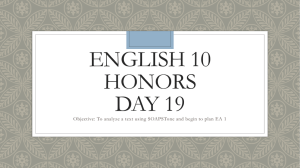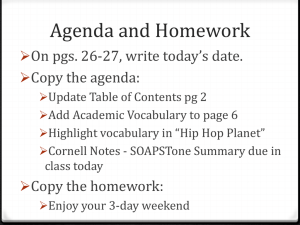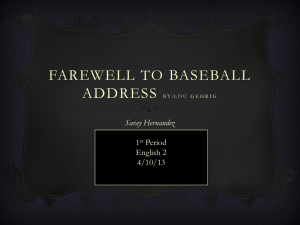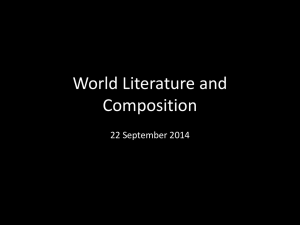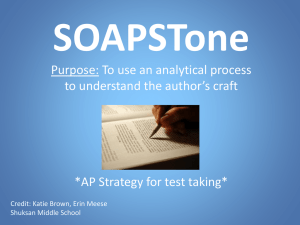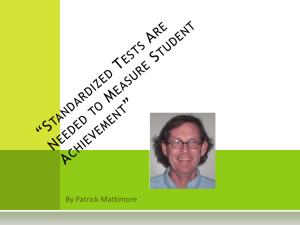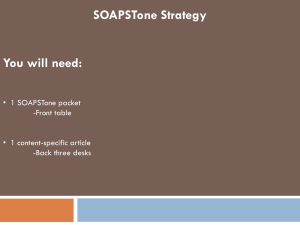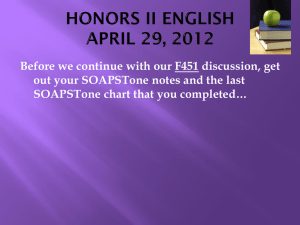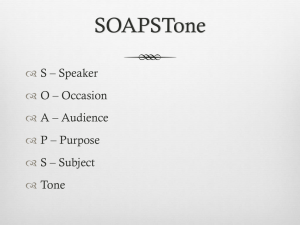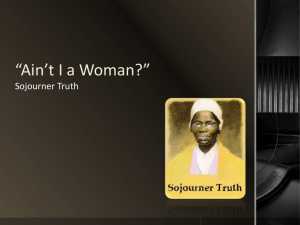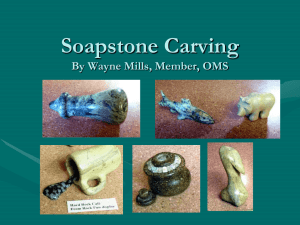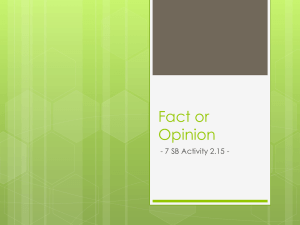What is SOAPSTone?
advertisement
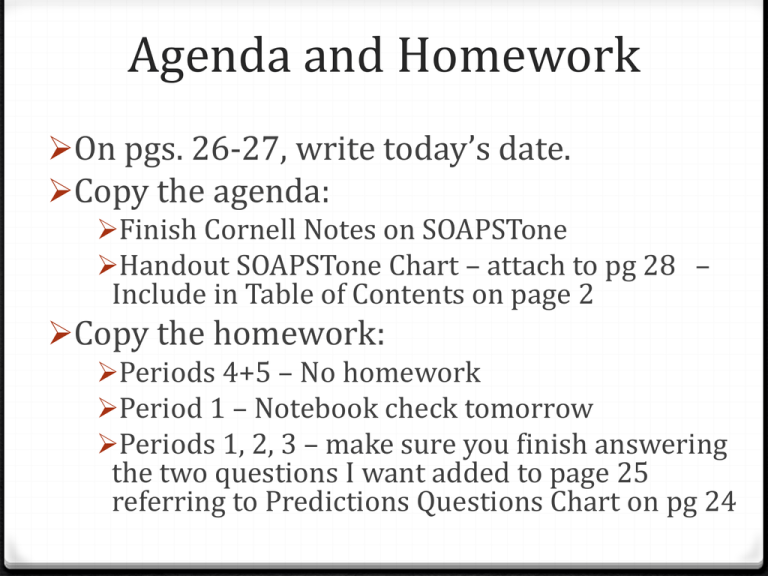
Agenda and Homework On pgs. 26-27, write today’s date. Copy the agenda: Finish Cornell Notes on SOAPSTone Handout SOAPSTone Chart – attach to pg 28 – Include in Table of Contents on page 2 Copy the homework: Periods 4+5 – No homework Period 1 – Notebook check tomorrow Periods 1, 2, 3 – make sure you finish answering the two questions I want added to page 25 referring to Predictions Questions Chart on pg 24 WARM-UP Answer the following question: In a complete sentence, explain why it is important to read the same text multiple times. How can reading the same text multiple times help you? The Last Two Questions from Tuesday Reviewing Predictions: Refer to your Making Predictions and Asking Questions Chart on pg. 24. Write you answers on the last page of “Hip Hop Planet” (pg 25). • Which of your predictions turned out to be true? • Did McBride answer any of the questions you asked? Cornell Notes: SOAPSTone On pg. 29 of your INB, take Cornell Notes. Essential Question? What is SOAPSTone? SOAPSTone is a reading and writing strategy. It helps you to identify the key elements of an expository text. SOAPSTone What is an expository text? It is used to explain, describe, give information, or inform. It is non-fiction. It has true facts It has a title. It may have an index, glossary, headings/subheadings It may have diagrams, photographs, bold words It is important to evaluate the author’s credentials SOAPSTone S = Subject (looking for the main idea) The general topic, content, and ideas in a text. You should be able to state the subject in a few words. Ask yourself: • What is the subject or topic of the text? • What theme or big picture do you see? • What is this piece about? SOAPSTone O = Occasion Writing does not occur in a vacuum. All writers are influenced by a larger occasion. An event or situation catches the writer’s attention and triggers a response. Ask yourself: What event or occasion do you think caused the author to write this piece/text? SOAPSTone A = Audience The audience is the group of people the writer intends to address. Before an author writes, he/she must determine the audience because the choice the choice of audience affects how and why an author writes the text. Ask yourself: To whom is the author writing? How do you know? SOAPSTone P= Purpose The reason behind the text. Authors need to consider the purpose of the text in order to determine the argument and its logic. To determine the reason, authors ask, “What do I want my audience to think or do as a result of reading my text?” SOAPSTone – Purpose Con’t Ask yourself: 1. What does the author want you to believe or understand? 2. What is the purpose of the text? (choose one) • To educate or inform (if the author’s position is neutral) • To persuade or convince (if the author’s position is negative or positive) • To reflect on important event or idea (poetry or personal narrative) SOAPSTone S = Speaker The voice that tells the story. Before an author begins to write, he/she must determine whose voice is going to be heard—a fictional character or the author him/herself? The voice of the speaker influences the meaning of the text. Ask yourself: What do we know about the speaker? How does his background affect his point of view on the subject? SOAPSTone Tone The attitude of the author. Authors communicate tone through diction (word choice), syntax (sentence construction), imagery (metaphors, similes, and other types of figurative language). SOAPSTone – Tone Con’t Ask yourself: What is the attitude of the speaker or writer as revealed by the choice of vocabulary? Tone words: academic, formal, informal, sarcastic, humorous, informative, reflective, persuasive, casual, argumentative, passionate, cautionary, condescending, respectful, etc. Classwork/Homework Attach the SOAPSTone Chart to pg. 28 (Left Side)
